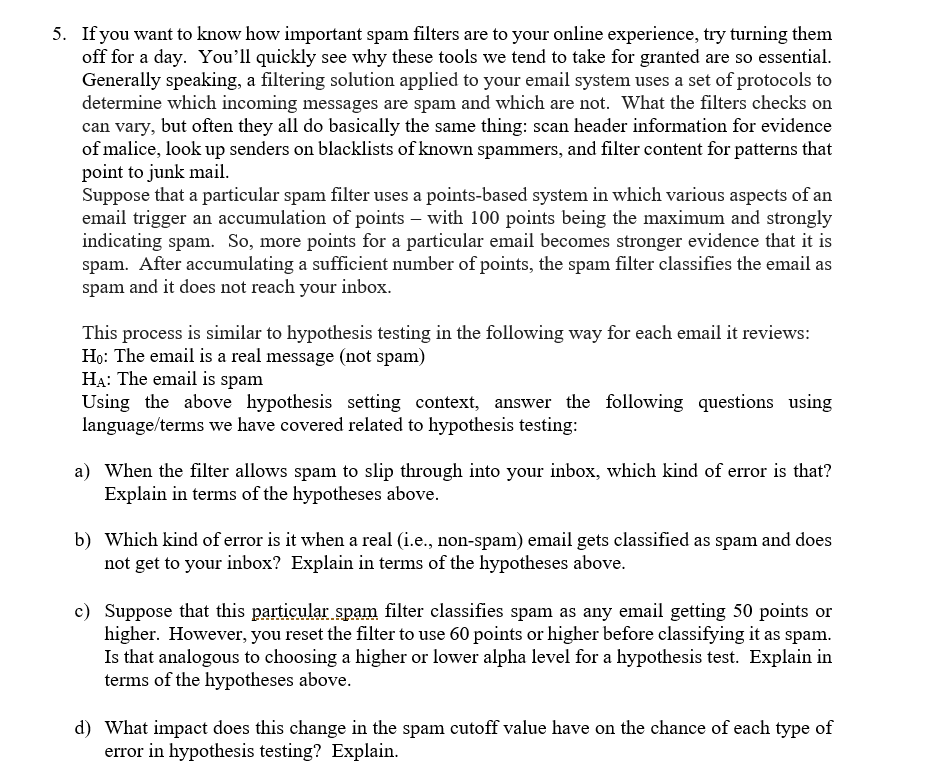d) What impact does this change in the spam cutoff value have on the chance of each type of error in hypothesis testing? Explain.
d) What impact does this change in the spam cutoff value have on the chance of each type of error in hypothesis testing? Explain.
MATLAB: An Introduction with Applications
6th Edition
ISBN:9781119256830
Author:Amos Gilat
Publisher:Amos Gilat
Chapter1: Starting With Matlab
Section: Chapter Questions
Problem 1P
Related questions
Topic Video
Question
Please help with question D.
Thanks

Transcribed Image Text:5. If you want to know how important spam filters are to your online experience, try turning them
off for a day. You'll quickly see why these tools we tend to take for granted are so essential.
Generally speaking, a filtering solution applied to your email system uses a set of protocols to
determine which incoming messages are spam and which are not. What the filters checks on
can vary, but often they all do basically the same thing: scan header information for evidence
of malice, look up senders on blacklists of known spammers, and filter content for patterns that
point to junk mail.
Suppose that a particular spam filter uses a points-based system in which various aspects of an
email trigger an accumulation of points – with 100 points being the maximum and strongly
indicating spam. So, more points for a particular email becomes stronger evidence that it is
spam. After accumulating a sufficient number of points, the spam filter classifies the email as
and it does not reach your inbox.
spam
This process is similar to hypothesis testing in the following way for each email it reviews:
Họ: The email is a real message (not spam)
HA: The email is spam
Using the above hypothesis setting context, answer the following questions using
language/terms we have covered related to hypothesis testing:
a) When the filter allows spam to slip through into your inbox, which kind of error is that?
Explain in terms of the hypotheses above.
b) Which kind of error is it when a real (i.e., non-spam) email gets classified as spam and does
not get to your inbox? Explain in terms of the hypotheses above.
c) Suppose that this particular spam filter classifies spam as any email getting 50 points or
higher. However, you reset the filter to use 60 points or higher before classifying it as spam.
Is that analogous to choosing a higher or lower alpha level for a hypothesis test. Explain in
terms of the hypotheses above.
d) What impact does this change in the spam cutoff value have on the chance of each type of
error in hypothesis testing? Explain.
Expert Solution
Step 1
Here our hypothesis is that,
H0: Not a spam v.s. HA: Email is spam.
Now, we classify an email as a spam if it gets 50 points or higher. 100 points being the maximum, this means, our level of significance or alpha here is (1- 0.5) =0.5, and we reject the null hypothesis if the filter point is < 0.5. Otherwise, we accept it and the e-mail classifies as not a spam.
If we change the filter point to 60, then automatically the level of significance changes to (1-0.6) = 0.4 and we reject the null hypothesis if our probability is < 0.4, and claim that it is a spam. Otherwise we accept it and say that our e-mail is not a spam.
Trending now
This is a popular solution!
Step by step
Solved in 2 steps

Knowledge Booster
Learn more about
Need a deep-dive on the concept behind this application? Look no further. Learn more about this topic, statistics and related others by exploring similar questions and additional content below.Recommended textbooks for you

MATLAB: An Introduction with Applications
Statistics
ISBN:
9781119256830
Author:
Amos Gilat
Publisher:
John Wiley & Sons Inc

Probability and Statistics for Engineering and th…
Statistics
ISBN:
9781305251809
Author:
Jay L. Devore
Publisher:
Cengage Learning

Statistics for The Behavioral Sciences (MindTap C…
Statistics
ISBN:
9781305504912
Author:
Frederick J Gravetter, Larry B. Wallnau
Publisher:
Cengage Learning

MATLAB: An Introduction with Applications
Statistics
ISBN:
9781119256830
Author:
Amos Gilat
Publisher:
John Wiley & Sons Inc

Probability and Statistics for Engineering and th…
Statistics
ISBN:
9781305251809
Author:
Jay L. Devore
Publisher:
Cengage Learning

Statistics for The Behavioral Sciences (MindTap C…
Statistics
ISBN:
9781305504912
Author:
Frederick J Gravetter, Larry B. Wallnau
Publisher:
Cengage Learning

Elementary Statistics: Picturing the World (7th E…
Statistics
ISBN:
9780134683416
Author:
Ron Larson, Betsy Farber
Publisher:
PEARSON

The Basic Practice of Statistics
Statistics
ISBN:
9781319042578
Author:
David S. Moore, William I. Notz, Michael A. Fligner
Publisher:
W. H. Freeman

Introduction to the Practice of Statistics
Statistics
ISBN:
9781319013387
Author:
David S. Moore, George P. McCabe, Bruce A. Craig
Publisher:
W. H. Freeman